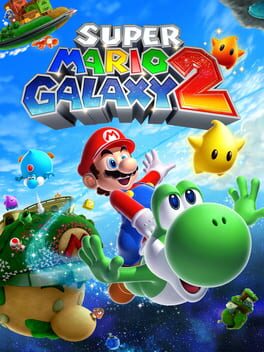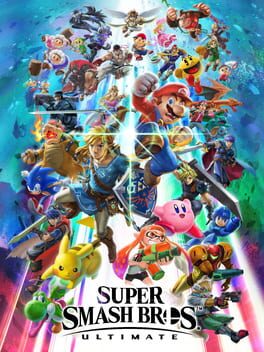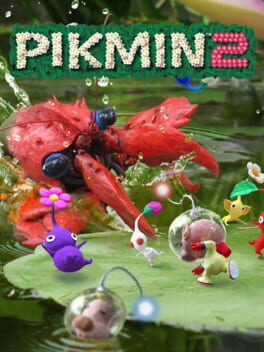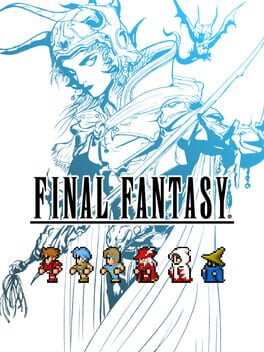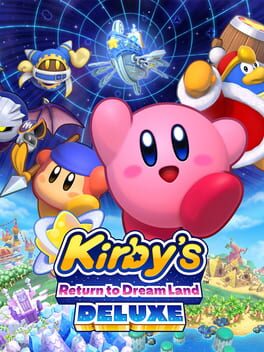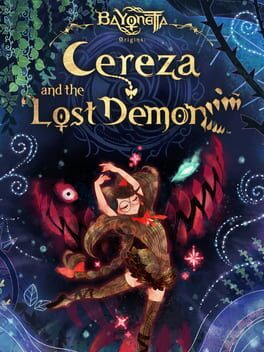AnthonyP
Bio
As seen on Nintendojo, Hey Poor Player, and my current home at GoNintendo. A game journo veteran of eight years, join me as we explore the never-ending mountain that is my gaming backlog!
As seen on Nintendojo, Hey Poor Player, and my current home at GoNintendo. A game journo veteran of eight years, join me as we explore the never-ending mountain that is my gaming backlog!
Badges

Best Friends
Become mutual friends with at least 3 others

1 Years of Service
Being part of the Backloggd community for 1 year

Noticed
Gained 3+ followers

Liked
Gained 10+ total review likes

Gone Gold
Received 5+ likes on a review while featured on the front page
Favorite Games
011
Total Games Played
000
Played in 2024
000
Games Backloggd
Recently Reviewed See More
When the slow triumph of the Final Fantasy theme swells during the finale, I can’t help but reflect upon the masterful bookend composing this first iteration. The Warriors of Light embark upon a basic objective – rescuing a princess from a dastardly villain -- only to dispense with that not even twenty minutes later, as the story diverts into a winding tale of airships, earth-rot, and time-loops. This subversion endures all the way up until the very end, melting the barrier between player and avatar via elucidative narration. In an era where 8-bit overworlds meant to convey larger-than-life scale with their pixelated dioramas, Final Fantasy embraces its Dungeons and Dragons-inspired identity by validating our interactivity – everything from the DIY headcanons birthed by our young brains to the hard-won strategic victories over Chaos’ forces given direct agency as a living, breathing game character.
In this modern-day Pixel Remaster, it’s a message I imagine that’ll echo most with younger players and gaming historians dipping their feet into gaming’s most illustrious RPG, and I’m not saying that because the formative years of hard-as-nails difficulty and the inviting canvas of sprite graphics are no longer the standard. It’s difficult to criticize a project stitched with such reverence towards its progenitor -- in particular, I am utterly seduced by the beautiful music score – yet not matter how much goodwill this Pixel Remaster bestows, I’m left walking away asking this: when did Final Fantasy become so easy?
As indicated by the rating, I’m not so quick to dismiss this remaster. Yet while this was probably inevitable -- as a grown man, I ain’t turning down autosave when I don’t have time for losing hours of grinding and prep from a Zombie ambush – everything is an absolute cakewalk right until the final boss fight: an inexplicable escalation into double-digit HP, cure-all magic, and party-wiping spells. It’s an imbalance at odds with the game’s class system, reaping little vindication for the set-ups and strategies so carefully considered from any one party formation. Some blame the retroactive functionality of our party’s tools (series staples Hi-Potions and Phoenix Downs hadn’t existed in the original); others, the buffs bestowed upon certain classes (the White Mage’s Life Magic originally didn’t work in battle). I’m sure the ardent Final Fantasy scholar can point out other things.
Whatever the case, we’re left on autopilot throughout the duration of Square-Enix’s formative adventure, and it’s a real shame given the apparent quality of everything else. The localized script is granted as much gravitas and character as the confines of 8-bit primitivism could possibly grant, and the fusion of precise pixelation married to modern effects is a sight to behold, not the least in the sparkling waters bobbling within the assortment of cozy hamlets offering sanctuary. Some have made no secret of their distaste for these graphical remasters; be it battle screen estate or the infamous “stuttering” defect – I confess to possessing a blind eye for the latter – yet I remain enthralled with their juxtaposition to the rearranged soundtrack: an authentic symphony illustrating the full breadth of medieval fantasy. (Derelict Keep being its most breathtaking example -- an ambient soundscape featuring melancholic strings, with the occasional whisper of a tambourine keeping us alert in the murky depths.)
Is this the definitive Final Fantasy? With the decades’ worth of remakes and ports, the cynical fan has been known to proclaim there is no such thing – too many variables in graphical and audio preference, convenience, content, localized scripts, and difficulty, they say, have made such a distinction impossible for any entry, and the Pixel Remasters are now but another side of the argument. To place my stake in the game: as an audiovisual experience, the Final Fantasy Pixel Remaster is the finest of vintage wine, instilling enough enthusiasm for the sequels. (Final Fantasy VI!) As a defanged classic, it’s not particularly ideal, but it’s hardly the worst option for an aspiring traveler to don the mantle of Warrior of Light. Pack your boots, fulfill your destiny, and soak yourself into that sweet, sweet yesteryear-flavored blend of nostalgia. Just don’t expect to be challenged.
In this modern-day Pixel Remaster, it’s a message I imagine that’ll echo most with younger players and gaming historians dipping their feet into gaming’s most illustrious RPG, and I’m not saying that because the formative years of hard-as-nails difficulty and the inviting canvas of sprite graphics are no longer the standard. It’s difficult to criticize a project stitched with such reverence towards its progenitor -- in particular, I am utterly seduced by the beautiful music score – yet not matter how much goodwill this Pixel Remaster bestows, I’m left walking away asking this: when did Final Fantasy become so easy?
As indicated by the rating, I’m not so quick to dismiss this remaster. Yet while this was probably inevitable -- as a grown man, I ain’t turning down autosave when I don’t have time for losing hours of grinding and prep from a Zombie ambush – everything is an absolute cakewalk right until the final boss fight: an inexplicable escalation into double-digit HP, cure-all magic, and party-wiping spells. It’s an imbalance at odds with the game’s class system, reaping little vindication for the set-ups and strategies so carefully considered from any one party formation. Some blame the retroactive functionality of our party’s tools (series staples Hi-Potions and Phoenix Downs hadn’t existed in the original); others, the buffs bestowed upon certain classes (the White Mage’s Life Magic originally didn’t work in battle). I’m sure the ardent Final Fantasy scholar can point out other things.
Whatever the case, we’re left on autopilot throughout the duration of Square-Enix’s formative adventure, and it’s a real shame given the apparent quality of everything else. The localized script is granted as much gravitas and character as the confines of 8-bit primitivism could possibly grant, and the fusion of precise pixelation married to modern effects is a sight to behold, not the least in the sparkling waters bobbling within the assortment of cozy hamlets offering sanctuary. Some have made no secret of their distaste for these graphical remasters; be it battle screen estate or the infamous “stuttering” defect – I confess to possessing a blind eye for the latter – yet I remain enthralled with their juxtaposition to the rearranged soundtrack: an authentic symphony illustrating the full breadth of medieval fantasy. (Derelict Keep being its most breathtaking example -- an ambient soundscape featuring melancholic strings, with the occasional whisper of a tambourine keeping us alert in the murky depths.)
Is this the definitive Final Fantasy? With the decades’ worth of remakes and ports, the cynical fan has been known to proclaim there is no such thing – too many variables in graphical and audio preference, convenience, content, localized scripts, and difficulty, they say, have made such a distinction impossible for any entry, and the Pixel Remasters are now but another side of the argument. To place my stake in the game: as an audiovisual experience, the Final Fantasy Pixel Remaster is the finest of vintage wine, instilling enough enthusiasm for the sequels. (Final Fantasy VI!) As a defanged classic, it’s not particularly ideal, but it’s hardly the worst option for an aspiring traveler to don the mantle of Warrior of Light. Pack your boots, fulfill your destiny, and soak yourself into that sweet, sweet yesteryear-flavored blend of nostalgia. Just don’t expect to be challenged.
You know, it’s funny: us Kirby fans lauded 2011’s Kirby’s Return to Dream Land as a belated return to form, siphoning the best of Kirby’s Adventure and Kirby Super Star to provide a full-fledged modern adventure after years of remakes, spin-offs, and outsourced entries. Yet over a decade later, with Triple Deluxe and Planet Robobot further perfecting the formula and Forgotten Land successfully paving the way for a 3D future, I gotta admit: Return to Dream Land is rather…well, ordinary.
Not that is new criticism, mind; critics and non-fans alike wrote off Kirby’s Wii adventure as an inoffensive, if not boring, venture that rounded out the dying Wii hardware. Yet where college freshman me championed how Return to Dream Land unapologetically modeled itself into a humble 90’s side-scrolling tribute – a veritable time capsule true to its localized name, earning it the No. 1 spot as my 2011 GOTY – this commitment to tradition leaves the game spinning its wheels. Much of the boilerplate settings breed tedium in their familiarity (Grassland? Check. Beach? Um, yay. Desert? Yawn.), and while the game’s punchy combat carries it through, Return to Dream Land’s momentum doesn’t take off until the late-game stages. The Super Abilities roar with excitement, but the emphasis on Kirby leaves it ill-suited for multiplayer sessions. The Extra Mode offers little more than a souped-up challenge, with the precedent of playable secondary heroes relegated only to the Arena.
And yet despite all that, it’s all tremendously meaty, with this Deluxe edition proving itself a bona fide buffet of collectibles, mini-games, and a much-needed epilogue. Really, us Kirby lore enthusiasts could’ve simply made do that with that last one – the Shinya Kumazaki era’s drive for riveting mythology surrounding a pink marshmallow is an astonishing gift unto itself – yet Deluxe goes above and beyond in what should’ve just been a competent remaster, right down to introducing two new Copy Abilities when it didn’t need to. The forgettable motion controlled mini-games are replaced by Merry Magoland, a Best-Of selection riding the climatic high of the series’ 30th anniversary, with each game complete with their respective badge-rewarding objectives. The Magolor Epilogue, a hi-score-styled episode emphasizing thrilling combos and a peek behind may well be Kirby’s most tantalizing character.
It’s all enough, even, that I’m still chugging away two-and-a-half months later, ready to tie the ribbon on Magoland’s hidden challenges. Granted, this was also the case with the tepid Kirby’s Dream Buffet, but whereas overeating was merely the duty of a Kirby completionist, Return to Dream Land Deluxe is a delectable smorgasbord I gratefully partake upon every time. That’s gotta count for something.
There is something to be said about opinions fluctuating through time, or games being more than the sum of their parts, or whether such remasters are worth the $60 entry tag. True to its humble 2011 release, Return to Dream Land Deluxe didn’t spark much discussion, so I shall rise to the occasion and say I’m simply grateful it exists at all. This commitment to tradition means Masahiro Sakurai’s design ethos of prioritizing the fledgling gamer is preserved for a new generation – a lifeline for those who cannot keep up with Mario’s platforms or Sonic’s speed, buoyed by Kirby’s infinite flight and Return to Dream Land’s multiplayer teamwork. (That, and well, it’s heartening how we bookend the dawn of a new era with the blueprint of modern Kirby: a sign that its 2D roots shan’t be uprooted and disposed away…as if there was any doubt!)
Such speaks to Return to Dream Land’s beating heart: there are no grand designs at play, merely a proud mission statement enduring three decades and counting. This delicate balance in satisfying all demographics isn’t without its stumbles – a patronizing Squeak Squad misstep here, an imbalanced Dream Land 2 see-saw there – but whereas Return to Dream Land is indeed ordinary, it’d difficult to imagine the Kirby of today divorced from this pledge to the familiar. Framed within Deluxe’s personalized glee in running around with a Waddle Dee mask (the cries of “Wanya!”, as so lovingly dubbed by Japanese fans, echoing with every input) and a nostalgic send-off to yet another anniversary, this remaster is a generous package I treasure.
(That all said, I’m gonna come out and say it: you can’t just take the exaggerated proportions of Dedede’s Forgotten Land motif, forcibly jam it into a small model, and not have it look, well, hideous. There’s brand consistency, and then there’s forcing a square peg into a round hole. Blegh!)
Not that is new criticism, mind; critics and non-fans alike wrote off Kirby’s Wii adventure as an inoffensive, if not boring, venture that rounded out the dying Wii hardware. Yet where college freshman me championed how Return to Dream Land unapologetically modeled itself into a humble 90’s side-scrolling tribute – a veritable time capsule true to its localized name, earning it the No. 1 spot as my 2011 GOTY – this commitment to tradition leaves the game spinning its wheels. Much of the boilerplate settings breed tedium in their familiarity (Grassland? Check. Beach? Um, yay. Desert? Yawn.), and while the game’s punchy combat carries it through, Return to Dream Land’s momentum doesn’t take off until the late-game stages. The Super Abilities roar with excitement, but the emphasis on Kirby leaves it ill-suited for multiplayer sessions. The Extra Mode offers little more than a souped-up challenge, with the precedent of playable secondary heroes relegated only to the Arena.
And yet despite all that, it’s all tremendously meaty, with this Deluxe edition proving itself a bona fide buffet of collectibles, mini-games, and a much-needed epilogue. Really, us Kirby lore enthusiasts could’ve simply made do that with that last one – the Shinya Kumazaki era’s drive for riveting mythology surrounding a pink marshmallow is an astonishing gift unto itself – yet Deluxe goes above and beyond in what should’ve just been a competent remaster, right down to introducing two new Copy Abilities when it didn’t need to. The forgettable motion controlled mini-games are replaced by Merry Magoland, a Best-Of selection riding the climatic high of the series’ 30th anniversary, with each game complete with their respective badge-rewarding objectives. The Magolor Epilogue, a hi-score-styled episode emphasizing thrilling combos and a peek behind may well be Kirby’s most tantalizing character.
It’s all enough, even, that I’m still chugging away two-and-a-half months later, ready to tie the ribbon on Magoland’s hidden challenges. Granted, this was also the case with the tepid Kirby’s Dream Buffet, but whereas overeating was merely the duty of a Kirby completionist, Return to Dream Land Deluxe is a delectable smorgasbord I gratefully partake upon every time. That’s gotta count for something.
There is something to be said about opinions fluctuating through time, or games being more than the sum of their parts, or whether such remasters are worth the $60 entry tag. True to its humble 2011 release, Return to Dream Land Deluxe didn’t spark much discussion, so I shall rise to the occasion and say I’m simply grateful it exists at all. This commitment to tradition means Masahiro Sakurai’s design ethos of prioritizing the fledgling gamer is preserved for a new generation – a lifeline for those who cannot keep up with Mario’s platforms or Sonic’s speed, buoyed by Kirby’s infinite flight and Return to Dream Land’s multiplayer teamwork. (That, and well, it’s heartening how we bookend the dawn of a new era with the blueprint of modern Kirby: a sign that its 2D roots shan’t be uprooted and disposed away…as if there was any doubt!)
Such speaks to Return to Dream Land’s beating heart: there are no grand designs at play, merely a proud mission statement enduring three decades and counting. This delicate balance in satisfying all demographics isn’t without its stumbles – a patronizing Squeak Squad misstep here, an imbalanced Dream Land 2 see-saw there – but whereas Return to Dream Land is indeed ordinary, it’d difficult to imagine the Kirby of today divorced from this pledge to the familiar. Framed within Deluxe’s personalized glee in running around with a Waddle Dee mask (the cries of “Wanya!”, as so lovingly dubbed by Japanese fans, echoing with every input) and a nostalgic send-off to yet another anniversary, this remaster is a generous package I treasure.
(That all said, I’m gonna come out and say it: you can’t just take the exaggerated proportions of Dedede’s Forgotten Land motif, forcibly jam it into a small model, and not have it look, well, hideous. There’s brand consistency, and then there’s forcing a square peg into a round hole. Blegh!)
Well, isn’t this interesting: whereas Bayonetta 3 just missed the landing (good game, mind; just missing a certain…something its predecessors lacked), I found myself quite taken by this left-field, humble spin-off starring the titular witch in her childhood. There’s none of the glitz and glamour in her adulthood years – just the pathos and doe-eyed wonder of a soul-searching child. Absent are the in-your-face sex or gratuitous gore rewarding our endless combo chains, substituted by the catharsis of a heartening coming-of-age story. It helps the plot is legible this time around: like all the best fairy tales, its storybook presentation makes us gasp and shriek with every page-turning twist, complete with a kindly narrator who, much like how your parents and teachers might’ve done for larger-than-life critters, intones a gruff, haughty growl for the Lost Demon himself.
Bayonetta Origins bears the Platinum seal of quality well – its DNA is evident in everything from secret challenges to hidden treasures to a rousing final boss fight—yet it’s a different breed from their usual fare of hi-scores and cutthroat action. Not that there’s anything wrong with experimentation, but Origins’ lethargy can sometimes be to its detriment – repetition can quickly breed in its forced encounters, and while Cheshire’s gradual new abilities are interesting, provide precious little ground for experimentation (Not that it was ever going to match the three Bayo game’s fertility on that front, mind; grafting juggling-filled combos onto the game’s the two-character control system would be a literal juggling act unto itself.)
But whatever missteps there may be, let us remember this is a different sort of Bayonetta – one substituting spectacle with a childlike wonder we may’ve lost within our own journey into adulthood, turning us bitter and cynical like Cereza’s tyrant of a teacher in Morgana. Were it not for the hair-rising monsters lurking within its depths, you’d almost never believe the mystical Avalon Forest is a realm of deadly frights: everything from Cheshire’s eye-popping transformations to the oversized fauna ferrying and bouncing our young witch along are imaginative boons for Origins’ dreamy setting: its cel-shaded graphics akin to tangible brushstrokes coming alive. Its lore is delightful as it is interesting, not the least in its ensemble of adorable, Dough Boy-esque Wisps: all lost, pitiful creatures trapped in Purgatory, complete with their respective backstories; a heart-wrenching incentive to aim for 100% completion. And we certainly can’t forget Cereza’s beautiful character arc – from subtle callbacks to Bayonetta (one particular boss being not-so-subtle, presenting a clever juxtaposition of Cereza’s growth) to all the trappings of a buddy road trip flick, the pitiful beginnings of young Cereza gradually blossom into the confident witch we’ve come to adore.
Some have questioned Origins’ branching out to a younger audience; myself, I’m grateful that, much like Cereza herself, it had the courage to try at all. Successfully forging uncharted ground for the series, it’s a spin-off that knows its boundaries, never outstaying its welcome and knowing just when to close the book. Where Bayonetta will go from here remains to be seen – I suspect the trials and tribulations surrounding Bayonetta 3 will give Platinum much pause on its future -- but in the advent of its newfound affinity for bedtime stories, I already anticipate the next chapter.
Bayonetta Origins bears the Platinum seal of quality well – its DNA is evident in everything from secret challenges to hidden treasures to a rousing final boss fight—yet it’s a different breed from their usual fare of hi-scores and cutthroat action. Not that there’s anything wrong with experimentation, but Origins’ lethargy can sometimes be to its detriment – repetition can quickly breed in its forced encounters, and while Cheshire’s gradual new abilities are interesting, provide precious little ground for experimentation (Not that it was ever going to match the three Bayo game’s fertility on that front, mind; grafting juggling-filled combos onto the game’s the two-character control system would be a literal juggling act unto itself.)
But whatever missteps there may be, let us remember this is a different sort of Bayonetta – one substituting spectacle with a childlike wonder we may’ve lost within our own journey into adulthood, turning us bitter and cynical like Cereza’s tyrant of a teacher in Morgana. Were it not for the hair-rising monsters lurking within its depths, you’d almost never believe the mystical Avalon Forest is a realm of deadly frights: everything from Cheshire’s eye-popping transformations to the oversized fauna ferrying and bouncing our young witch along are imaginative boons for Origins’ dreamy setting: its cel-shaded graphics akin to tangible brushstrokes coming alive. Its lore is delightful as it is interesting, not the least in its ensemble of adorable, Dough Boy-esque Wisps: all lost, pitiful creatures trapped in Purgatory, complete with their respective backstories; a heart-wrenching incentive to aim for 100% completion. And we certainly can’t forget Cereza’s beautiful character arc – from subtle callbacks to Bayonetta (one particular boss being not-so-subtle, presenting a clever juxtaposition of Cereza’s growth) to all the trappings of a buddy road trip flick, the pitiful beginnings of young Cereza gradually blossom into the confident witch we’ve come to adore.
Some have questioned Origins’ branching out to a younger audience; myself, I’m grateful that, much like Cereza herself, it had the courage to try at all. Successfully forging uncharted ground for the series, it’s a spin-off that knows its boundaries, never outstaying its welcome and knowing just when to close the book. Where Bayonetta will go from here remains to be seen – I suspect the trials and tribulations surrounding Bayonetta 3 will give Platinum much pause on its future -- but in the advent of its newfound affinity for bedtime stories, I already anticipate the next chapter.
